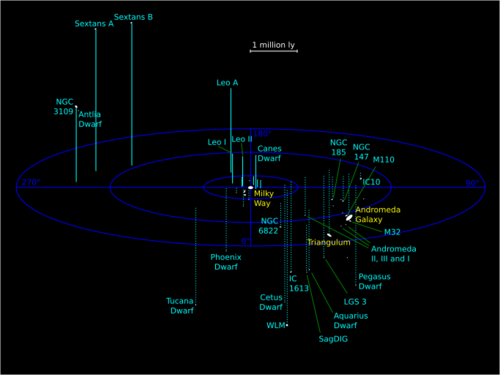Pegasus Dwarf Irregular Galaxy
Topic: Astronomy
 From HandWiki - Reading time: 3 min
From HandWiki - Reading time: 3 min
| Pegasus Dwarf Irregular Galaxy | |
|---|---|
 Pegasus Dwarf Irregular Galaxy (Pegasus Dwarf), DDO 216, UGC12613 | |
| Observation data (J2000 epoch) | |
| Constellation | Pegasus |
| Right ascension | 23h 28m 36.2s[1] |
| Declination | +14° 44′ 35″[1] |
| Redshift | −183 ± 0 km/s[1] |
| Distance | 3.0 ± 0.1 Mly (920 ± 30 kpc)[2] |
| Apparent magnitude (V) | 13.2[1] |
| Characteristics | |
| Type | dIrr/dSph[1][a] |
| Apparent size (V) | 5.0′ × 2.7′[1] |
| Other designations | |
| UGC 12613,[1] PGC 71538,[1] DDO 216,[1] Pegasus Dwarf,[1] PegDIG[1] | |
The Pegasus Dwarf Irregular Galaxy (also known as Peg DIG or the Pegasus Dwarf) is a dwarf irregular galaxy in the direction of the constellation Pegasus. It was discovered by A. G. Wilson in the 1950s. The Pegasus Dwarf is a companion of the Andromeda Galaxy in the Local Group.
General information
In 1975 Tully & Fisher determined that it was part of the Local Group.[3] The metallicity and the related distance estimate has been subject to discussions in the scientific literature, with varying results; however, recently, by use of the tip of the red-giant branch, a distance within 10% error was achieved in 2000[4][5] and then improved to 3% in 2005.[2]
In popular culture
The science fiction television series Stargate Atlantis takes place in the "Pegasus galaxy" and has shown images of an irregular galaxy. However, the franchise has not explicitly stated if it is the Irregular, Spheroidal, or an entirely fictional location,[6] but since the series claimed the Pegasus galaxy to be 3 million light years away, it is likely the irregular one.
See also
- Pegasus Dwarf Spheroidal Galaxy (Peg dSph)
- Pegasus galaxy, the Stargate Atlantis fictional location.
Notes
References
- ↑ 1.00 1.01 1.02 1.03 1.04 1.05 1.06 1.07 1.08 1.09 1.10 "NASA/IPAC Extragalactic Database". Results for PegDIG. http://nedwww.ipac.caltech.edu/cgi-bin/nph-objsearch?objname=Pegasus+Dwarf#ObjNo1. Retrieved 2007-03-15.
- ↑ 2.0 2.1 McConnachie, A. W.; Irwin, M. J.; Ferguson, A. M. N.; Ibata, R. A.; Lewis, G. F.; Tanvir, N. (2005). "Distances and metallicities for 17 Local Group galaxies". Monthly Notices of the Royal Astronomical Society 356 (4): 979–997. doi:10.1111/j.1365-2966.2004.08514.x. Bibcode: 2005MNRAS.356..979M.
- ↑ Gallager, J S.; Tolstoy, E.; Dohm-Palmer, Robbie C.; Skillman, E D.; Cole, A A.; Hoessel, J G.; Saha, A.; Mateo, M. (1998). "A Wide Field Planetary Camera 2 Study of the Resolved Stellar Population of the Pegasus Dwarf Irregular Galaxy (DDO 216)". The Astronomical Journal 115 (5): 1869–1889. doi:10.1086/300328. Bibcode: 1998AJ....115.1869G. https://www.rug.nl/research/portal/en/publications/a-wide-field-planetary-camera-2-study-of-the-resolved-stellar-population-of-the-pegasus-dwarf-irregular-galaxy-ddo-216(9e84a3d9-98a1-45ad-9bab-3d703d3b0eba).html.
- ↑ Karachentsev, Igor D.; Karachentseva, Valentina E.; Huchtmeier, Walter K.; Makarov, Dmitry I. (2004). "A Catalog of Neighboring Galaxies". The Astronomical Journal 127 (4): 2031–2068. doi:10.1086/382905. Bibcode: 2004AJ....127.2031K.
- ↑ van den Bergh, Sidney (2000). The Galaxies of the Local Group. Cambridge, UK: Cambridge University Press. ISBN 0-521-65181-6. Bibcode: 2000glg..book.....V.
- ↑ "The Return" (Stargate Atlantis)
- ↑ Cole, Andrew A.; Tolstoy, Eline; Gallagher, John S., III; Hoessel, John G.; Mould, Jeremy R.; Holtzman, Jon A.; Saha, Abhijit; Ballester, Gilda E. et al. (1999). "Stellar Populations at the Center of IC 1613". The Astronomical Journal 118 (4): 1657–1670. doi:10.1086/301042. Bibcode: 1999AJ....118.1657C.
External links
- Pegasus Dwarf Irregular Galaxy on WikiSky: DSS2, SDSS, GALEX, IRAS, Hydrogen α, X-Ray, Astrophoto, Sky Map, Articles and images
Coordinates: ![]() 23h 28m 36.2s, +14° 44′ 35″
23h 28m 36.2s, +14° 44′ 35″
 |
 KSF
KSF
